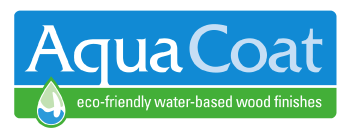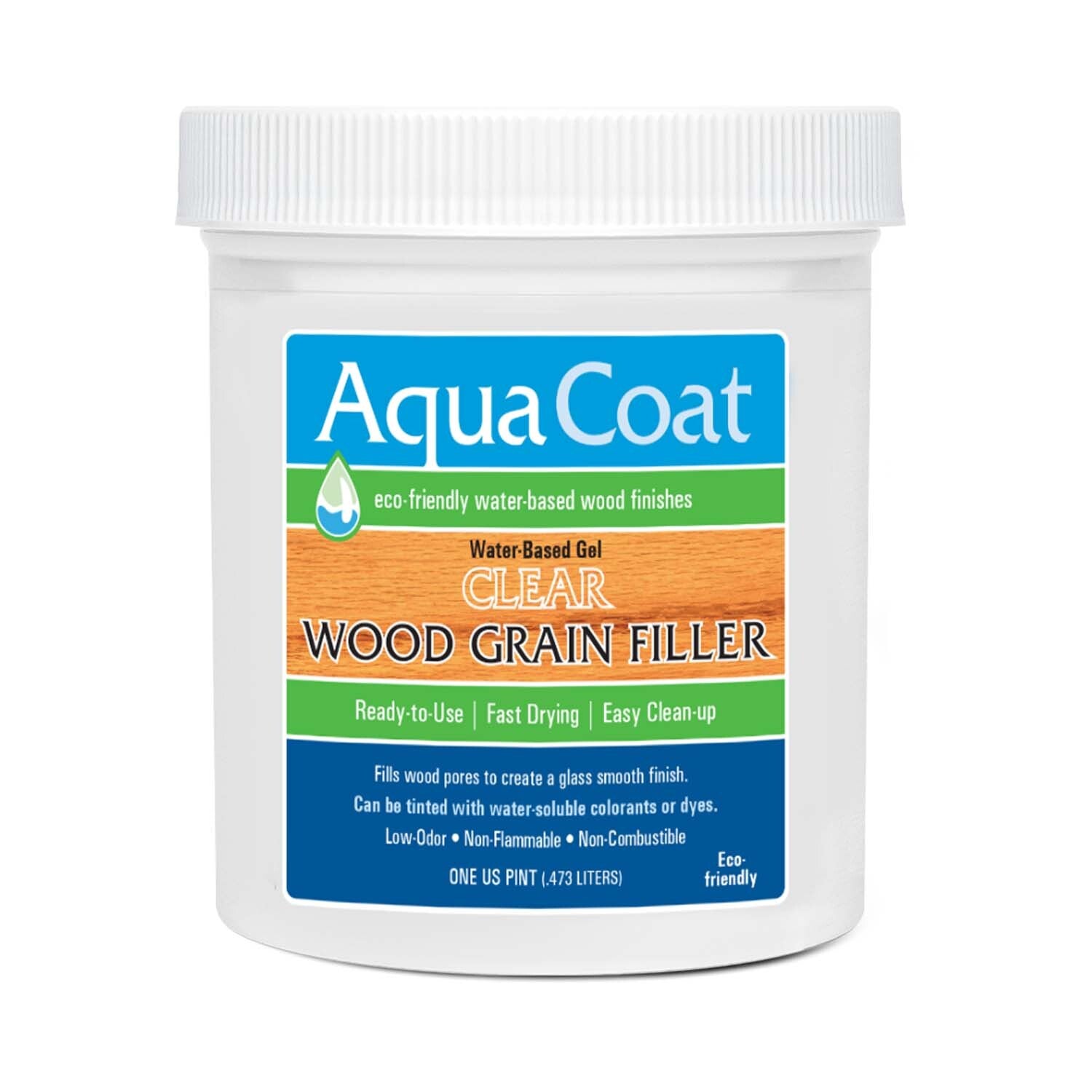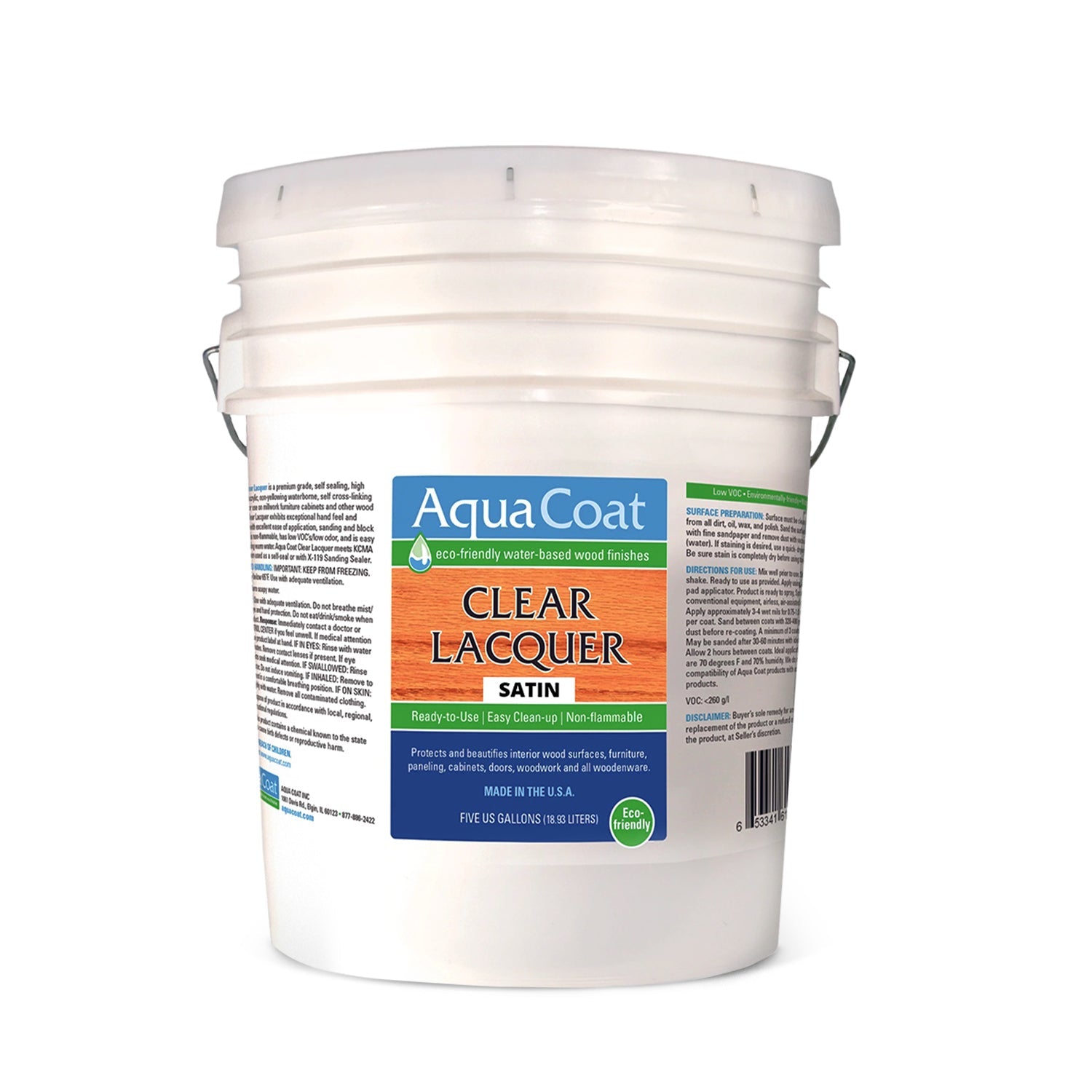Expert Wood Finishing Tips
1: Surface Preparation for Wood Finishing
Sand the surface with 150-grit or finer paper and remove dust with air or a water-dampened cloth. The surface must be free of dirt, oil, wax, solvents, and any other chemical residue before finishing. You may choose to apply Aqua Coat Clear Stain Base before your final sanding. This will eliminate most grain raise issues and will reduce the “blotchiness” that occurs with some softwoods such as poplar and basswood and some of the nicer hardwoods such as cherry and walnut. Clear Stain Base also works as a pre-stain, wood conditioner, or wood-prep that many of the major stain manufacturers recommend when finishing.
If the wood has been chemically stripped, the wood surface must be neutralized. If a wood bleach has been applied to brighten the color, bleach must be neutralized with a diluted solution of oxalic acid or vinegar prior to sealing and finishing.
2: Optional Step
Fill open grain wood with Aqua Coat Clear Grain Filler. Using the filler before you stain will inhibit the stain's ability to penetrate into the wood grain. This would be desirable if you are trying to minimize the contrast of grain.
3: Apply Stain
Brush, wipe, spray, or dip. Wipe the excess stain with a dry clean cloth or paper towel. Allow 30 to 60 minutes to dry. Drying time can be reduced with gentle air movement, such as a window or box fan on low to medium speed.
4: Apply Sanding Sealer
Spray or brush medium wet coat. Allow 30 to 60 minutes of dry time. If your sandpaper gums up, allow additional dry time, or use a fan as suggested in step #3.
Scuff sand with 220-grit or finer sandpaper.
Clean off dust with a damp cloth. We offer two uniquely different Sanding Sealers. Aqua Seal is an amber-toned penetrating product that performs much like organic shellac. The “X-119” Sanding Sealer is a high-solids, high-build sealer that acts much like a top coat, but is formulated for easy sanding. We suggest a maximum of 2 coats with either sealer. (Note: For hard or tight-grained wood such as maple, birch, cherry, and plywood, when finishing, we recommend the “X-119” Sanding Sealer, as you will get better inter-coat adhesion.) If you are going to brush your sealer coats, adding 10-30% of the Aqua Coat Retarder will give you additional open or drying time so the brush strokes will flow out. We suggest 2 full coats of the sanding sealer, without sanding between coats. Sanding only after the 2nd coat of sealer gives a thicker film coat, eliminating any grain raising between coats and reducing your chance of sanding through the stain.
5: Optional Step
If a closed-grain look is desired, you may elect to use Aqua Coat Clear Grain Filler. In the container, it has the appearance of white school paste or Crisco shortening. It can be applied in several ways, such as a small rubber squeegee, an old credit card, or a grey or white buffing pad. Another popular method is to apply it much like a paste wax with a circular motion, working it into the grain, applying 1 or 2 coats as needed. The filler sticks to raw wood or any type of finish and can be applied between coats instead of all at once. It dries completely clear, but any excess should be removed before drying. Any residue remaining should be sanded off with the sealer.
6: Apply Clear Finishing Coat to Your Wood
Spray or brush a medium coat. Plus or minus 1 mil. is a good starting point. Please experiment with a sample board to get the desired results before starting your final project. With HVLP Spray Technology, 3 or 4 light to medium coats may give you the best results. For standard air compressor or air-assisted airless, etc., use a 1 to 2 mil. thickness per application, with a total of 2 to 3 coats. You may use as many topcoats as you deem necessary to achieve your desired results. ( IMPORTANT! Make sure your topcoats are completely dry before you apply the next coat of finish. Usually 3 coats per day maximum is a good rule of thumb.) The addition of Aqua Coat Reducer will slightly lower the viscosity of your topcoats. This reduces the chance of defects in the appearance of your finish, such as “orange peel” which is caused by insufficient atomization. Use a 10-30% maximum. Allow 30 to 60 minutes of dry time. Again, you may add gentle air movement to alter dry times. For ultimate smoothness, allow the final coat to naturally air dry. The addition of a 10-30% retarder in your final coat of finish will slow down the dry time and allow the film to more completely drawdown for a smooth look and feel.
If you sand between your topcoats, use a 320-grit or finer sandpaper. If the sandpaper does not gum up, this is a good indication that the film coat is dry. You may use steel wool substitutes, such as 3M’s Scotch Brite Pads. Use the grey (very fine) or white (extra fine). Never use regular steel wool pads as they are treated with oil to keep them from rusting. Any residue from this oil may cause water-based finishes to appear milky or cloudy and could interfere with inter-coat adhesion. If any steel fibers remain after sanding, they would show up as rust or black spots in your finish. If you wish to brush your topcoats, you can use Aqua Coat Brushable Urethane Varnish. It should be applied with a high-quality synthetic bristle brush or a fine napped paint pad. For smaller surface areas, the paint pads work quite well with our regular topcoats.
If you choose, you may buff or wax your final finish. Make sure your topcoats are completely dry before you aggressively buff or apply any wax. Make sure that the selected waxes are free of any solvents that might soften the fresh finish. Think of the water-based coatings more like the clear coats on your car or truck rather than the standard furniture lacquers you might be used to. Again, we suggest experimenting with a sample board finished like your final project in order to develop a polishing method that works for you.
Some people have achieved excellent results with the new Micro Abrasives that are used in the automotive industry. The sandpapers used for the polishing of water-based coatings are in the 2,000 to 6,000 grit range. The European versions of these are sold in micron ratings and will be as fine as 12,000 microns (grit). These are available from most auto body supply shops, online woodworking supply stores, and at most woodworking shows.





